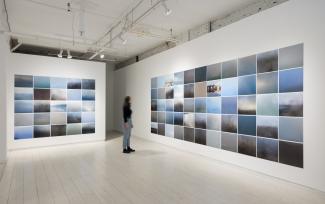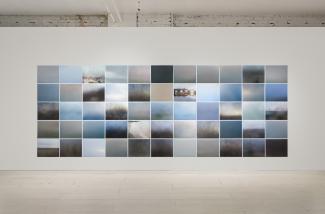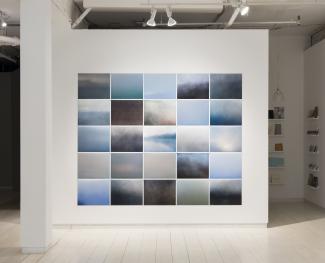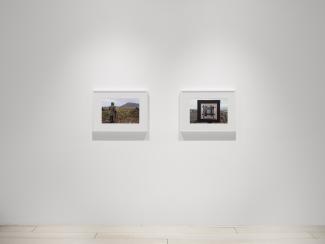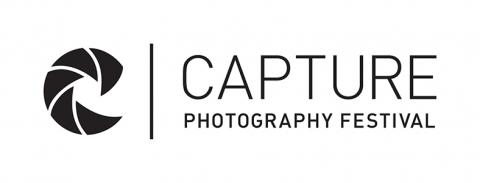There is a tenacity in Karen Zalamea’s work; in her persistent attempts to record, in her laborious process, and in her unbending attachment to chance. Through her materially-driven process, Zalamea asks, “Can the landscape reveal and render its own photographic image?”[1]
They are lost as soon as they are made is a long-term photographic project begun by Zalamea during an artist residency in 2015, and continued in a second trip to Iceland in late 2018. To produce her images, Zalamea handcrafted a large-format 4x5-inch analogue film camera, and froze local water samples in specially fabricated lens moulds. Using these basic technological implements, she captured numerous sites around Iceland, resulting in the selection of colour photographs exhibited at Access Gallery. Unable to know what might result from each exposure, Zalamea’s process questions the presumption of documentary truth. In the four years since beginning this project, she’s reconsidered what 'clear articulations’ of the landscape might actually mean. What results are “a range of descriptive landscapes, ghostly impressions, atmospheric tones, and optical aberrations. [This project] is as much about the mechanism, the process and its variable qualities as it is about trying to capture the landscape.”[2]
Anthropologist Tim Ingold proposes that scholars have for generations hinged their art historical analysis of landscape on an etymological error.[3] The suffix -scape originates from Old English sceppan (to shape) and -scope from the classical Greek skopos (a bowman’s target). So, landscape came to be associated with descriptive scenery, aligned with pictorial renderings by painters—and photographers to follow.[4] Forming water into a mechanism for taking scope, Zalamea steps back into the role of landshaper, giving renewed attention to the materiality of landscape, and the labour of being perceived.
While beginning this work in 2015, Zalamea visited Roni Horn’s project, The Library of Water (Icelandic: Vatnasafn), in Stykkishólmur, Iceland. In housing twenty-four columns of melted ice from across Iceland, Horn’s intention was to preserve some memory of the water-sources, which Jeanette Winterson describes as “endangered glaciers brought into captivity.”[5] Distorting the view of the space around them, some are clear but others contain traces of debris or are replete to the point of opacity.[6] In Saying Water, Horn writes, “water is transparence derived from the presence of everything.”[7]
Quoted from Independent People (Icelandic: Sjálfstætt fólk) by Halldór Laxness, published in 1934/35, Zalamea’s title for this body of work, They are lost as soon as they are made, is pulled from the novel’s description of footprints in the snow. The image speaks to weather, mark-making, the embodied experience of moving from one space to the other, and the landscape’s temporality.
They are lost as soon as they are made
found
when
before they are made
they are found
once they are made
once they
are lost
as soon as they are found
I can’t seem to hold the series’ title in my mind. Since our first studio visit, I’ve written seemingly unending permutations of this sentence in error, transposing and replacing its components. My linguistic somersaults speak perhaps to the mutability to which the phrase points. Subarctic Phase speaks similarly to being in (and then out of) synchrony: disappearing footprints followed by others slightly off step, melting lenses capturing changing light, repetition, and resolve. This project presents a sustained effort by the artist as she grasps at something that is continually shifting. The landscape perceiving and being perceived by itself. Water captured and also capturing: the sky, the ground, the horizon.
Photographers refer to the mechanics of the ‘camera body’—not to mention its mimicry of the function of our ocular lenses. But what of the marrow of a photograph, or even, of a landscape? In previous texts, I’ve considered the body of a drawing; the accretion of marks on a ground as much a corporeal structure as a surface. Thinking the ground itself, I’m reminded of Halifax-based Estonian artist, Juss Heinsalu, who projects light through lenses fired from what ceramicists refer to as the ‘clay body’.
Zalamea has, with previous work, been “attentive to the material surface or, as she calls it, the topographical ‘skin’ of a landscape.”[8] With Subarctic Phase, however, she invites the body of the landscape itself into the method, giving in to her subject’s corporeal agency.
Drawing on a larger photographic practice which investigates the nature of image making, this project was initiated by an interest in the mechanics of photography, requiring only a light-tight box with an aperture, a focusing mechanism, a light-sensitive recording material, light, and time. Refusing to fall victim to the idealization of Iceland’s frozen ‘wilderness,’ with Subarctic Phase, Zalamea subverts a problematic legacy of the picturesque, upending expectations held of large-format location-based photography. Like with her previous works exploring iconic American landscapes, Zalamea aims, “to demystify the construct of idealized views, especially with Iceland’s heavily documented vistas from increased tourism and frequent location use in Hollywood films.“[9]
This work is the result of time spent in a sublime environment, but hearing Zalamea describe her process removes any romanticism. This repetitive gesture, the physical rigour of setting up and taking down, the unknown result—this is not an artist consuming a vista. Zalamea chases time, shooting in limited daylight, counting aloud as she holds each exposure, ultimately allowing the material, rather than her photographer’s eye, to record the site. As Zalamea lists the steps required to capture these images, it becomes clear that the already laborious nature of large-format analogue photography is exacerbated by the challenging conditions in which she is working: the limited light in this far-North environ in winter, the cumbersome lenses kept in a portable cooler, exposure to the elements, and travelling in an unheated car. It was, as she has said, not a vacation.
“If all of the photos are blank, I will have carried a wooden box around.”
-Karen Zalamea
What results in this installation is an imposing grid of primarily unrecognizable forms in varying tones and hues. Some lenses resulted in fracturing, drips, and disruptions. While some are clear, others are purely textural. In composing the photographs, Zalamea chose information that may have registered photographically. Of course there are decisions here—there are preferred or anticipated results. “Some of the photos include watermarks or chemical drips on the developed negatives, and arguably these were not present during the exposure. I’ve decided to keep them in as a continuation of the liquid process.”[10]
Through the grid, we are confronted with the repetition of Zalamea’s process, breaking the notion of the horizon through its own reiteration. Eschewing the pseudo-scientific approach in favour of an intuitive one, she presents results of the experiment but not its methodology. One imagines a rigorous cataloguing to determine which lens resulted in the most ‘successful’ record. But this presumes that representation was the goal. There are other truths.
In The Miracle of Analogy, Kaja Silverman describes photography as a means by which the world reveals itself to us; that it begins not “when we decide that it should, or end[s] when we command it to. Photography develops, rather, with us, and in response to us.”[11] She challenges the notion that a camera is necessarily either an aggressive tool used by a human to assert power, or an indexical tool pointing directly to an absent referent—just as the footprints in the snow attests to the existence of the person who had made them.[12] Silverman unearths in Walter Benjamin’s texts a position that photography is “a disclosive rather than an evidentiary truth,” and that he “attributes it to the world, instead of to technology, treats it as an analogy, instead of an index or a copy, and associates it with development, instead of fixity.”[13]
Embedded in Zalamea’s process, the resulting work, and the history in which it sits, is a questioning of legibility. In translation theory, a lacuna refers to something that is untranslatable, or a lexical gap. They are lost as soon as they are made considers the translational potential of photography, both what can be rendered from one form to another—and what cannot.[14]
Katie Belcher, curator
[1] Notes from the artist
[2] Notes from the artist
[3] Introduction to Critical Landscapes, Art, Space, Politics, Ed. Emily Eliza Scott and Kirsten Swenson, 2015
[4] Tim Ingold, “Landscape or Weather-World?,” in Being Alive: Essays on Movement, Knowledge,
and Description (London: Routledge, 2011), 126–27.
[5] Jeanette Winterson, Roni Horn – Entering the Flow-World, March 6th, 2009, accessed April 15 2019 http://www.jeanettewinterson.com/journalism/roni-horn-entering-the-flow-world/
[6] “The Library of Water is a long-term project that has set out to capture the spirit of Iceland through its waters, weather, and words.” https://www.libraryofwater.is/project.html
[7] Roni Horn’s Saying Water was read aloud by a river’s edge at the Two days art-festival at the Louisiana Museum of Modern Art, in May 2012 accessed 25 April 2019 https://www.youtube.com/watch?v=fkvoe7s1NVg
[8] Exhibition statement for When the sun rises, we keep the fire aflame, BAF Gallery, 22 March to 12 May 2018
[9] Notes from the artist
[10] Notes from the artist
[11] Kaja Silverman, The Miracle of Analogy, Stanford University Press, 2014, 12
[12] Silverman, 3
[13] Silverman, 8
[14] Notes from the artist
